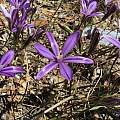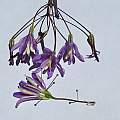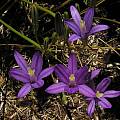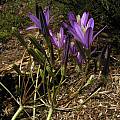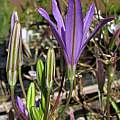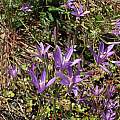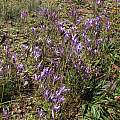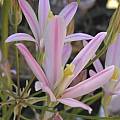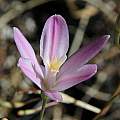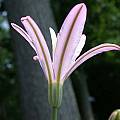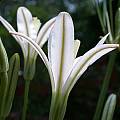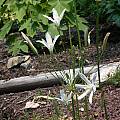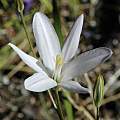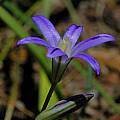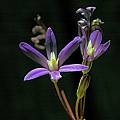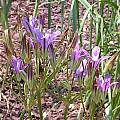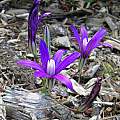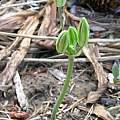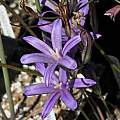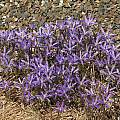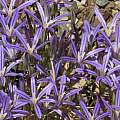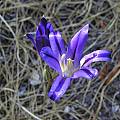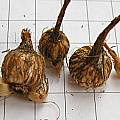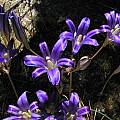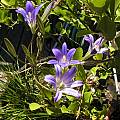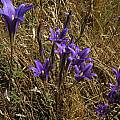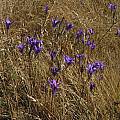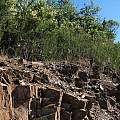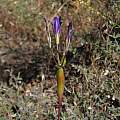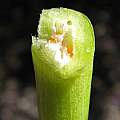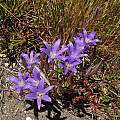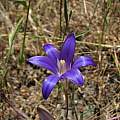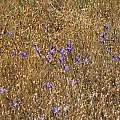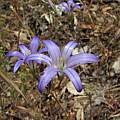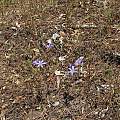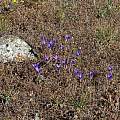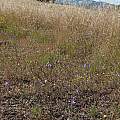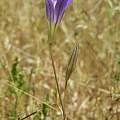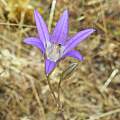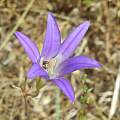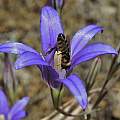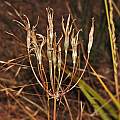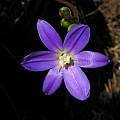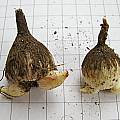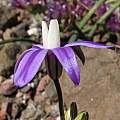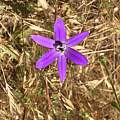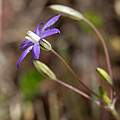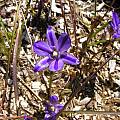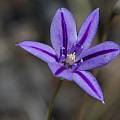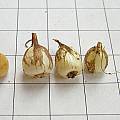Brodiaea is a genus restricted to western North America, ranging geographically from Vancouver, B.C. to Baja California. This genus is in the Liliaceae, Asparagaceae or Themidaceae family depending on which taxonomists you follow. Brodiaea species a-j are found on this wiki page. More information can be found on the main Brodiaea wiki page.
Brodiaea appendiculata Hoover is found in valley grasslands, open woodlands, gravelly clay soil from the San Francisco Bay Region to the Sierra Nevada foothills of California. Blooming from April-May with violet purple flowers, this species grows to 17 in. (43 cm) and is very similar to Brodiaea californica with flowers curving upward and with linear white wavy staminodes longer than the functional stamens, but is differentiated by having forked linear appendages on the back of each anther. Only one other species has appendages (Brodiaea stellaris) and it is a much shorter plant. The photo below was taken by Nhu Nguyen at the UC Botanical Garden.
Brodiaea californica Lindl. ex Lem. is endemic to California and is found growing in light woods and open meadows in Northern California. It is the largest of the species, growing from 20-80 cm high. Blooming from May to July, it is variable in color from white to lavender and occasionally pink with long, gradually flared petals and short rounded tubes and linear white wavy staminodes longer than the stamens and standing against them. Photo 1 from Richard Haard illustrates the structure of the flower. Photos 2-3 are pictures of a lavender form blooming June and July 2004 and growing in the ground taken by Mary Sue Ittner and are views looking down at the flowers and directly across so you can see the form and the staminodes. Photos 4-6 were taken by Nhu Nguyen. Photo 4 is of his plant and photos 5-6 were taken at the Tilden Botanic Garden.
The photos below illustrate a pink form. Photos were taken by Bob Rutemoeller, Mary Sue Ittner, John Lonsdale and Nhu Nguyen. The last was taken at the UC Botanical Garden.
The photos below illustrate a white form. Photos 1-2 were taken by John Lonsdale, photo 3 by Mary Sue Ittner and the last by Nhu Nguyen at the UC Botanical Garden.
Brodiaea californica ssp. leptandra is restricted to lava and serpentine slopes in Napa, Lake, and Sonoma counties and is generally smaller (shorter and with smaller flowers). It has been elevated in the Jepson Manual to species level.
Brodiaea coronaria (Salisb.) Jeps. is found in the hills of northern and central California, usually in meadows, often in clay, gravely alkaline soil and extends north to Oregon and Washington and southern British Columbia. Flowers are blue-violet, blue-purple, pink-purple or rose and blooming occurs from May to July. Growing from 5 to 25 cm, flowers have a bell-shaped tube curving upwards and white to purple hornlike staminodes that lean inward but are not appressed around the fertile stamens. Photos 1-2 were taken by Mary Sue Ittner. Photo 3 was taken by John Lonsdale, and photos 4-5 were contributed by Kathleen Sayce of garden grown plants. Photo 6 was taken by Nhu Nguyen.
Brodiaea coronaria ssp. coronaria is widespread with blue-purple perianth. The photos below were taken by Nhu Nguyen at the UC Botanical Garden.
Brodiaea coronaria ssp. rosea (Greene) Niehaus is found only in the Inner North Coast Ranges of California (Tehama County, Lake County) and has rose-purple perianth. In the second edition of The Jepson Manual it has been elevated to species status as Brodiaea rosea.
Brodiaea elegans Hoover is found is meadows and open woods, mostly inland from Central California north to southern Oregon. It has blue-purple to violet flowers in a funnel shaped tube and is distinguished by white pointed staminodes which stand against the tepals and away from the stamens. Plants can grow to 50 cm tall. It blooms from May to July, often after the leaves have withered. There are two subspecies, ssp. elegans, native from southwest Oregon to California and ssp. hooveri Niehaus native to western Oregon.
Photos 1-2 by Mary Sue Ittner show a close-up of the flowers and the corms on a 1 cm grid. Photos 3-4 were taken by Bob Rutemoeller. Photo 4 shows one growing in a tub with a Meyer lemon where it gets regular water and fertilizer with a lot of nitrogen and is obviously thriving in spite of that. Also in this tub is a Zephyranthes candida which bloomed dramatically in the fall of 2002 when the lemon tree didn't get enough water and dried out losing its leaves.
Photos 1-2 were taken by Bob Rutemoeller of plants in habitat near Auburn, California where they were blooming early June 2006 in a field of drying grass. Photos 3-5 were taken by Nhu Nguyen off HW140 near Chinese Camp. Photos 4 shows a gall on the peduncle of the plant. Photo 5 shows a broken gall with orange cecidomyiid fly larvae inside.
Photos 1-2 were taken by Bob Rutemoeller June 2011 in Sonoma County, CA on the Mendocino Sonoma coast where they were growing inland along Tin Barn Road. Photos 3-6 were taken by Nhu Nguyen at Armstrong Redwood State Natural Reserve in Sonoma County where color variations of this species can be seen.
Photos 1-2 were taken by Nhu Nguyen on Ring Mountain.
Photo by Travis Owen including with pollinators and drying seed pods.
Brodiaea filifolia S.Watson is commonly known as the thread-leaved brodiaea and is endemic to California and considered endangered. It is found in clay soil in vernal-pool habitats and grassland in Southern California. It flowers from April to June and the red-purple to blue flower tube is short and urnlike with the petals at right angles. It is distinguished by 3 white staminodes that are tiny and narrowly triangular. Height range: 20-30 cm. The second photo is a picture of the corms on a 1 cm grid. Photos by Bob Rutemoeller and Mary Sue Ittner. In Northern California this species blooms very late after the leaves are gone and often leans on a long stem with few flowers. It is easy to miss.
Brodiaea insignis (Jeps.) Niehaus is known from approximately twenty populations in the watersheds of the Tule and Kaweah Rivers in Tulare county, California, occurring in clay soil on granitic substrate in valley grassland and foothill woodland. It has rose to pink-purple flowers, spreading petals and grows to 10 in (25 cm) tall. It is distinguished by white staminodes that are held close to the stamens and are strongly inrolled. The first photo below was taken by Nhu Nguyen at the Tilden Botanic Garden. The second photo from iNaturalist taken by nancyb in Tulare County in May and shared under a CC BY-NC license. The last photo from Calflora taken by Joe Engelbrecht in Tulare County in May and shared under a CC BY-NC license.
Brodiaea jolonensis Eastw. is commonly known as Jolon brodiaea and is found in grasslands and foothill woodlands in the central and south Coast Ranges to northern Baja California. Blooming from April to June, this is a short species, growing to 6 in. (15 cm) with violet blossoms and an urn-shaped tube with erect violet staminodes slightly inrolled margins and purple anthers. Photos by Bob Rutemoeller and Mary Sue Ittner. The last picture shows the corms on a 1 cm grid.
